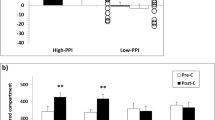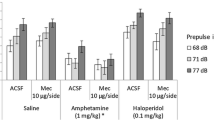Abstract
Prepulse inhibition (PPI) of the startle reflex – whereby presentation of a weak prepulse preceding a startling pulse diminishes the amplitude of the startle reflex – is disrupted by dopamine (DA) agonists; this disruption can be reversed by antipsychotics. There are also some indications in the literature that a few antipsychotics (most notably clozapine and haloperidol) may, on their own, have effects opposite to those of DA agonists, i.e. may enhance PPI. In order to explore these antipsychotic-induced potentiations of PPI more thoroughly, we assessed, in Sprague-Dawley rats, the effects of IP administration of various clinically effective antipsychotics in a PPI procedure with levels of PPI (ranging from 5 to about 40%) low enough to facilitate detection of PPI-potentiating effects of drugs. Both clozapine (5–20 mg/kg) and haloperidol (0.25–1 mg/kg) robustly and dose-dependently potentiated PPI. A similar effect was not seen with risperidone (0.1–1 mg/kg) or with the three substituted benzamides amisulpride (10–60 mg/kg), raclopride (0.1–3 mg/kg) and remoxipride (1–10 mg/kg). As risperidone is known to have prominent 5-HT2 antagonistic activity, these results do not indicate a role for 5-HT2 receptors in the clozapine and haloperidol PPI-enhancing effects. The absence of effects with the benzamides and with risperidone, at doses with known anti-dopaminergic activity, suggests that DA antagonist activity is not involved. The demonstration that prazosin (3–20 mg/kg), a non-antipsychotic with α1 adrenoceptor antagonistic properties, dose-dependently potentiated PPI indicates that α1 receptors might mediate the clozapine and haloperidol PPI-enhancing activity. Additionally, the finding that diazepam (1–10 mg/kg) did not enhance, but on the contrary reduced PPI, argues against a sedation- or general depressant-mediated effect of clozapine, haloperidol and prazosin. The negative results with four clinically active antipsychotics (risperidone and the benzamides), and the positive result with the non-antipsychotic prazosin, indicate that this PPI-enhancing procedure has poor predictive validity as a screening tool for potential antipsychotics.
Similar content being viewed by others
Author information
Authors and Affiliations
Additional information
Received: 14 November 1996/Final version: 6 February 1997
Rights and permissions
About this article
Cite this article
Depoortere, R., Perrault, G. & Sanger, D. Potentiation of prepulse inhibition of the startle reflex in rats: pharmacological evaluation of the procedure as a model for detecting antipsychotic activity. Psychopharmacology 132, 366–374 (1997). https://doi.org/10.1007/s002130050357
Issue Date:
DOI: https://doi.org/10.1007/s002130050357




